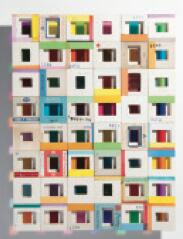Marcelo Cidade/ Lia Chaia
Galeria Vermelho, Sao Paulo
Is Modernism dead? Long live Modernism! In the exhibition “Avant-Gard is not dead”, artist Marcelo Cidade (São Paulo, 1979) revisits some of the fundamental references of the Brazilian Modernist movement from Hélio Oiticica’s environments, through the tropicalist tenets, to Lina Bo Bardi’s architectonic paradigm. Rather than a nostalgic gaze, the show features an investigation of the ideals imported from 20th century European avant-garde move- ments, and of the specific characteristics that modernism acquired in Brazil, especially in the sphere of architecture.

Cement, typical of large modernist buildings and a recurring material in several of Cidade’s earlier works, is used in the installation “Triste Tropicália”, in which cement pillars serve as support for samambaia ferns, in an allusion to the fundamental dialogue between orderly architecture and wild nature. The show also includes the photo installation “Modelo de Superfície”, the drawing “Condominio”, and six photographs that constitute the work Espacio Ciego. In the sculpture Despropriacion, Cidade reconstructs the Frei Egídio chair an icon of modernist design, created by Lina Bo Bardi using pink plywood (a material used in the panelling of large buildings or in favelas). The new chair, by the way, does not resist the weight of a person, introducing a questioning or a trap in relation to the spectator’s participation in the work.
At the same time, the gallery exhibits “Anônimo”. Here, the body, its fluids, fragilities, rhythms and vibrations serve as raw material for Lia Chaia’s (São Paulo, 1978) new artistic searches, investigating the adaptation of the body (the “natural”) to urban life (the “cultural”). Chaia’s works refer us simultaneously to both universes. In her most recent works, the relationship between the body’s primordial architecture and the architecture fabricated in the city is no longer one of constant clash or friction, a characteristic which had permeated his earlier works. The body now emerges already inserted in and adapted to the urban space, confirming its flexibility and its capacity for adaptation. The first impact is the one produced by Fachadeira, a panel that ocupies the entire façade of the gallery. The work was created on a nylon fabric similar to the one that covers buildings under construction in the city. On the 15 by 8 meter surface, the artist imprinted the configuration of the vertebrae in a spine. Bones, muscles, skin also constitute the raw material for the videos, photographs, drawings and collages displayed inside the exhibition.






